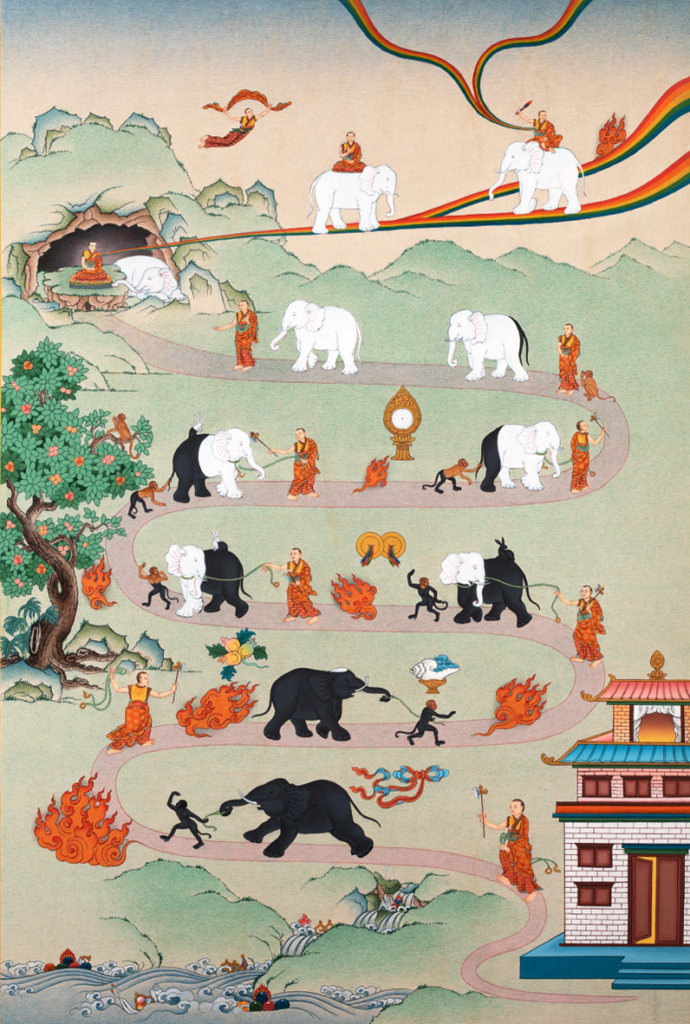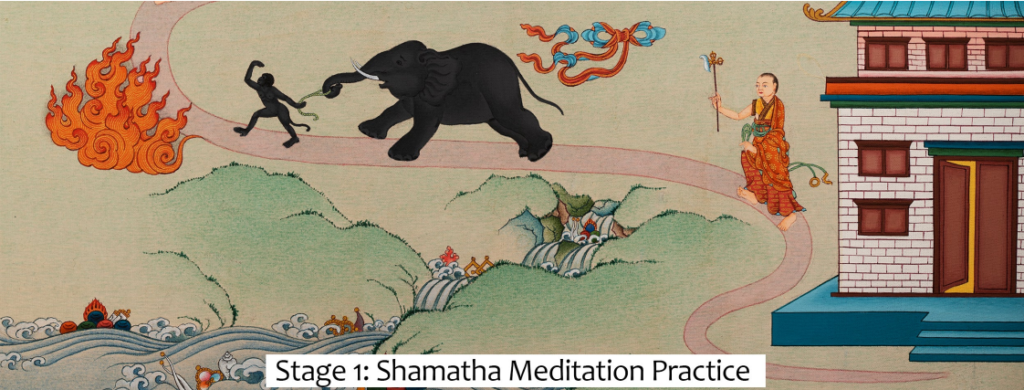The Tibetan word for Samatha means Calm (Tib: Zhi gnas). The practice of Samatha Meditation develops the ability to focus the mind in single-pointed equipoise or perfect concentration. It is practiced in a secluded place, adopting the “Seven point meditation posture of Vairochana”.

On the thangka nine progressive stages of mental development are shown. “Six powers of Study, Contemplation, Memory, Comprehension, Diligence and Perfection. A burning flame on a side, which shows the degree of effort required to develop both the mindful recollection, and the understandings. This flame gradually diminishes in each progressive stage. Here are the nine stages of meditation.
Stage 1, The power of Study:

The monk is shown holding a hooked goad and a lasso, which represent the clear understanding and the mindful recollection. The elephant represents the mind and its black color, the mental dullness. The monkey is the distraction or mental agitation. It is also black in color.
This stage is achieved through the power of study or hearing. The monk fixes his mind on the object of concentration. He is depicted as chasing the elephant with his lasso and hooked goad. The monkey runs wildly, leading the elephant.
Stage 2, Power of Concentration:

This stage is attained through the power of concentration and lengthening the period of concentration on the object.
There are the five sense object offerings: the Silk (touch), the fruits (taste), the conch (smell), cymbals (sound) and the mirror (sight). These are the objects of distraction.
The elephant and the monkey begin to turn white from their heads, which shows the continuous progress in fixing, and holding the object of concentration.
Stages 3 & 4, Power of Memory:

These stages are attained through the power of memory and recollection. The meditator here, hold the clear and detailed conception of the object. The monk finally lassoes the elephant and fixes the wandering mind of the object. The hare, which now appears on the elephant’s back, representing the more subtle aspect of sinking or mental torpor. All the elephant, monkey and the hare looks back, having recognized the objects of mental distraction.
Stages 5 & 6, Power of Comprehension:

This stage of Shamatha meditation is attained by absorbing the power of clear comprehension.
The monkey now follows the elephant. The monk hook the elephant with his goad, which shows that the mind has stopped from wandering. As the hare disappears in this stage, the mind is controlled and pacified.
Stage 7 & 8, Power of Diligence:

These stages are attained through the power of energetic perseverance.
Now the monkey leaves the elephant and squats behind the monk, in complete submission. There are still the traces of black on the elephant which means that the subtlest sinking and scattering may continue to arise.
In the 8th stage, the monkey disappears and the elephant is completely white. This represents the single pointedness of mind.
Stage 9, Power of Perfection:

This is the stage of perfect equanimity. As the path has ended, elephant is now at rest. From the heart of monk, emanates a rainbow.
The upper part of the thangka represents the tenth and the eleventh stages where:
- The monk flies alone, Bodily bliss.
- He rides the elephant, Attainment of Shamatha.
- Riding the elephant across the rainbow, Mental bliss.
The monk wields the flaming sword of perfect insights and rides along the rainbow. From his heart, emanates the two dark rainbows which represents the karmic hindrances, mental illusion and the obscurations of the instincts of mental distortion.



